It started during the “bad old days” of the early 1980s: Businesses banding together to change their neighborhoods for the better. Through a self-imposed tax, commercial property owners in an area would fund services to clean up their neighborhoods and make them safer for customers.
The gamble worked, and business improvement districts are one of the initiatives credited with turning the city around. These days, there are almost two dozen in Brooklyn alone, where they are trying to balance what’s best for businesses with the needs of their longtime neighbors who fear the threat of gentrification.
In the following pages, meet the BIDs that are building a more bustling Brooklyn.
86th Street Bay Ridge Business Improvement District
Leaders: Patrick Condren, executive director; Steve Petros, president
Budget: $290,000
Key projects: Sanitation, holiday lighting, streetscape installation and maintenance
Founded: October 2001
A Q&A with the 86th Street Bay Ridge BID
What accomplishments are you most proud of?
Increased shopping in the district.
How has the focus of your organization evolved over the years?
The 86th Street Bay Ridge BID’s focus remains on sanitation and communication with property owners and merchants.
Are there any legislative and/or policy issues that you’re currently focused on?
The 86th Street Bay Ridge BID is not involved in legislative or policy issues.
Atlantic Avenue Business Improvement District
Leader: Sara Nordmann, executive director
Budget: $410,000
Key projects: Horticulture program, faces of Atlantic Avenue holiday marketing program, coordinating special events, holiday lights, litter pickup, graffiti removal, advocacy on behalf of small businesses
Founded: 2011
A Q&A with the Atlantic Avenue BID
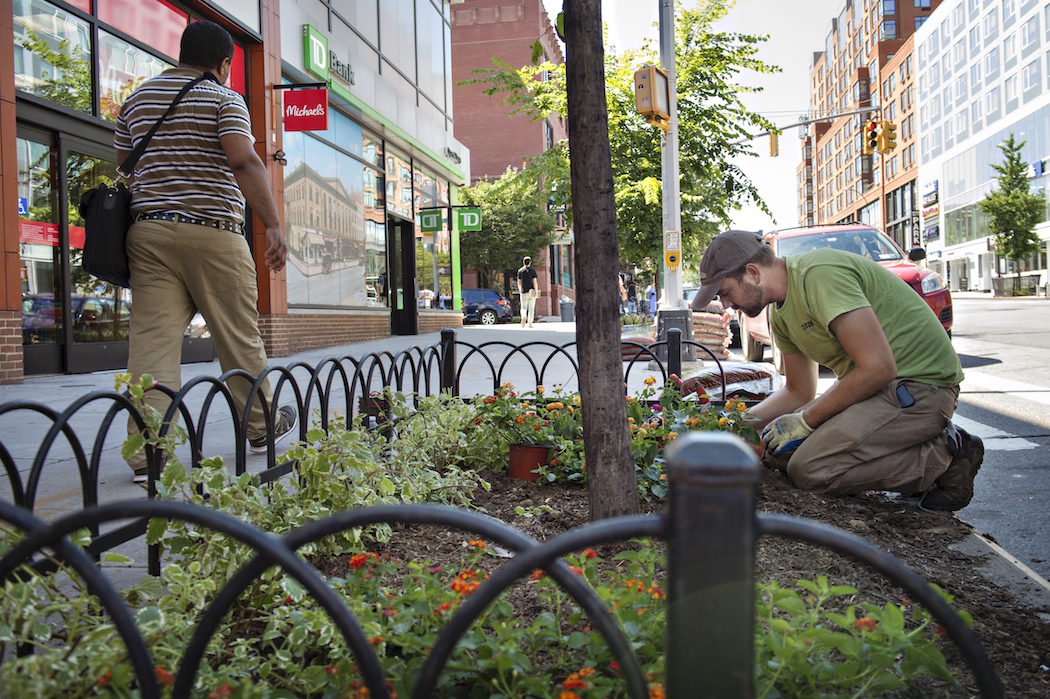
What challenges are you currently facing in your district? What accomplishments are you most proud of?
One challenge we’re currently facing is the issue of businesses on Atlantic Avenue being sued for noncompliance with the Americans with Disabilities Act, sometimes by unscrupulous lawyers looking for a quick cash settlement. I’m most proud of the way we’ve been able to consistently keep our corridor clean and inviting. We’ve vastly improved the streetscape by adding tree guards to eligible tree pits, planting flowers in those tree pits, successfully advocating for additional tree plantings and expeditiously removing graffiti.
Are there any legislative and/or policy issues that you’re currently focused on?
The multiyear discussion on the city’s proposed borough-based jails plan to replace Rikers Island was one that we were heavily focused on and involved in because the Brooklyn Detention Complex is located within the BID’s boundaries. Now that the conversation has largely been settled, we are monitoring the progression of the Small Business Jobs Survival Act in (the) City Council, which could affect the rate of new business openings on Atlantic Avenue if passed. We’re also involved in the discussions on the reconstruction of the Brooklyn-Queens Expressway, and the proposed Brooklyn-Queens Connector project.
Bay Ridge Fifth Avenue Business Improvement District
Leader: Amanda Zenteno, executive director
Budget: $569,000
Key projects: We focus on making Fifth Avenue a vibrant and healthy commercial corridor with seven days of supplemental sanitation services, security, avenue beautification, special events and merchant support.
Founded: June 2006
A Q&A with the Bay Ridge Fifth Avenue BID
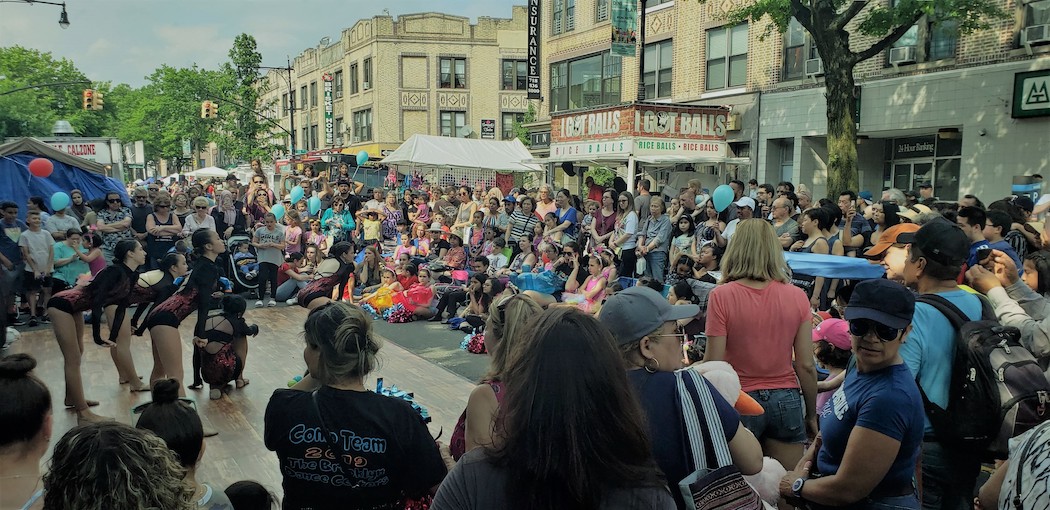
What challenges are you currently facing in your district?
As the commercial landscape changes and it becomes more difficult to draw a new customer base, the BID is addressing that challenge with a focus on direct merchant support. We work with individual businesses to design websites and set up social media accounts as well as provide specially designed marketing materials, all free of charge. We have had a great deal of success with our community events by rebranding Fifth Avenue and focusing on including cultural programming for all ages, which resulted in increased attendance and merchant participation.
How has the focus of your organization evolved over the years?
While we maintain our sanitation, safety and avenue beautification programs, we now have a more selected focus on community building. Fifth Avenue is the most diverse area within Bay Ridge, home to the largest Arabic speaking population in New York City. We enlarged our focus to ensure all stakeholders are represented with cultural programming, translation services and support that is individualized and specific to merchants and residents’ needs. Our work aims to be inclusive and culturally representative of all those who call Fifth Avenue home.
Bed-Stuy Gateway Business Improvement District
Leader: Medina Sadiq, executive director
Budget: $740,000
Key projects: Supplemental sanitation, public safety, marketing and merchant services
Founded: March 2009
A Q&A with the Bed-Stuy Gateway BID
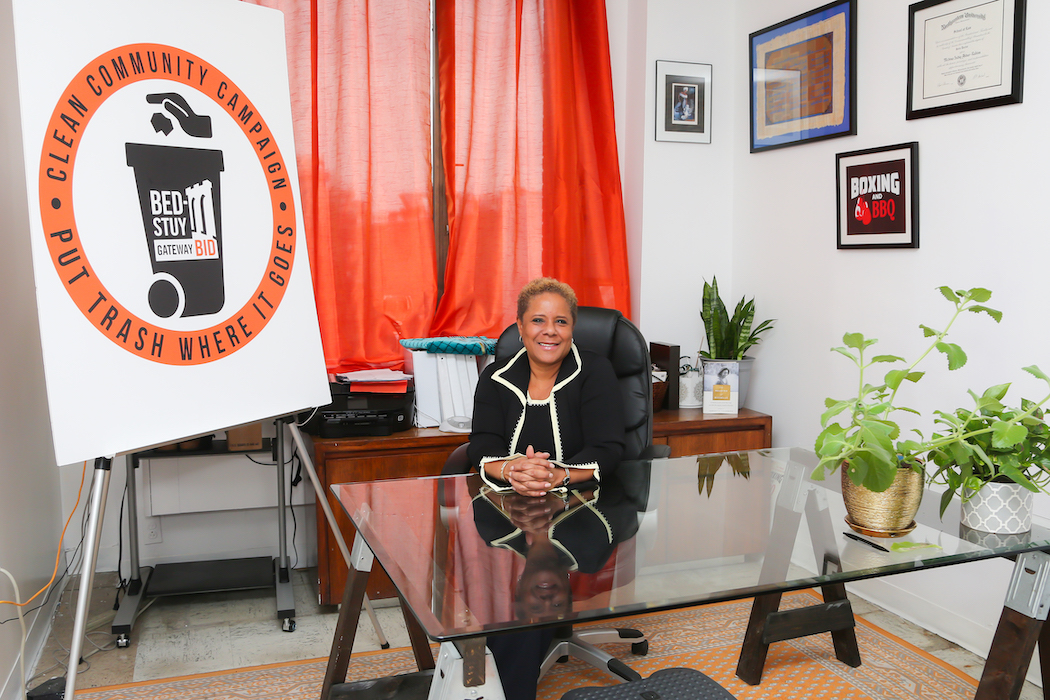
What challenges are you currently facing in your district?
Current challenges include balancing gentrification and merging new business and older businesses to achieve a blended business environment.
What accomplishments are you most proud of?
In the past 10 years, the BID has played a major role in making Bed-Stuy a destination, thereby attracting new businesses and tremendous real estate investment. In the past couple of years, the BID has done a tremendous job of sweeping the streets, managing trash and illegal dumping, as well as extermination and rat mitigation in Marcy Plaza. The BID is much cleaner than it has ever been before. With the creation of a new deputy director position, the BID has been able to dedicate itself to supporting new businesses to develop into long-term successful ventures.
Are there any legislative and/or policy issues that you’re currently focused on?
We’re seeking funding to develop a community-based crime reduction plan and funding for the district. We’re also working with the Department of Sanitation to develop better procedures for the collection and management of local trash.
Brighton Beach Business Improvement District
Leaders: Yelena Makhnin, executive director; Seth Rubinstein, president
Assessment: $220,000
Founded: January 1987
Responses: Declined to answer
Church Avenue Business Improvement District
Leaders: Lauren Elvers Collins, executive director; Handel Edwards, board chair
Assessment: $203,000
Key projects: Sidewalk sales weekends, supplemental sanitation, holiday lights, annual street fair and the production of a wall calendar highlighting local businesses
Founded: 1984
A Q&A with the Church Avenue BID
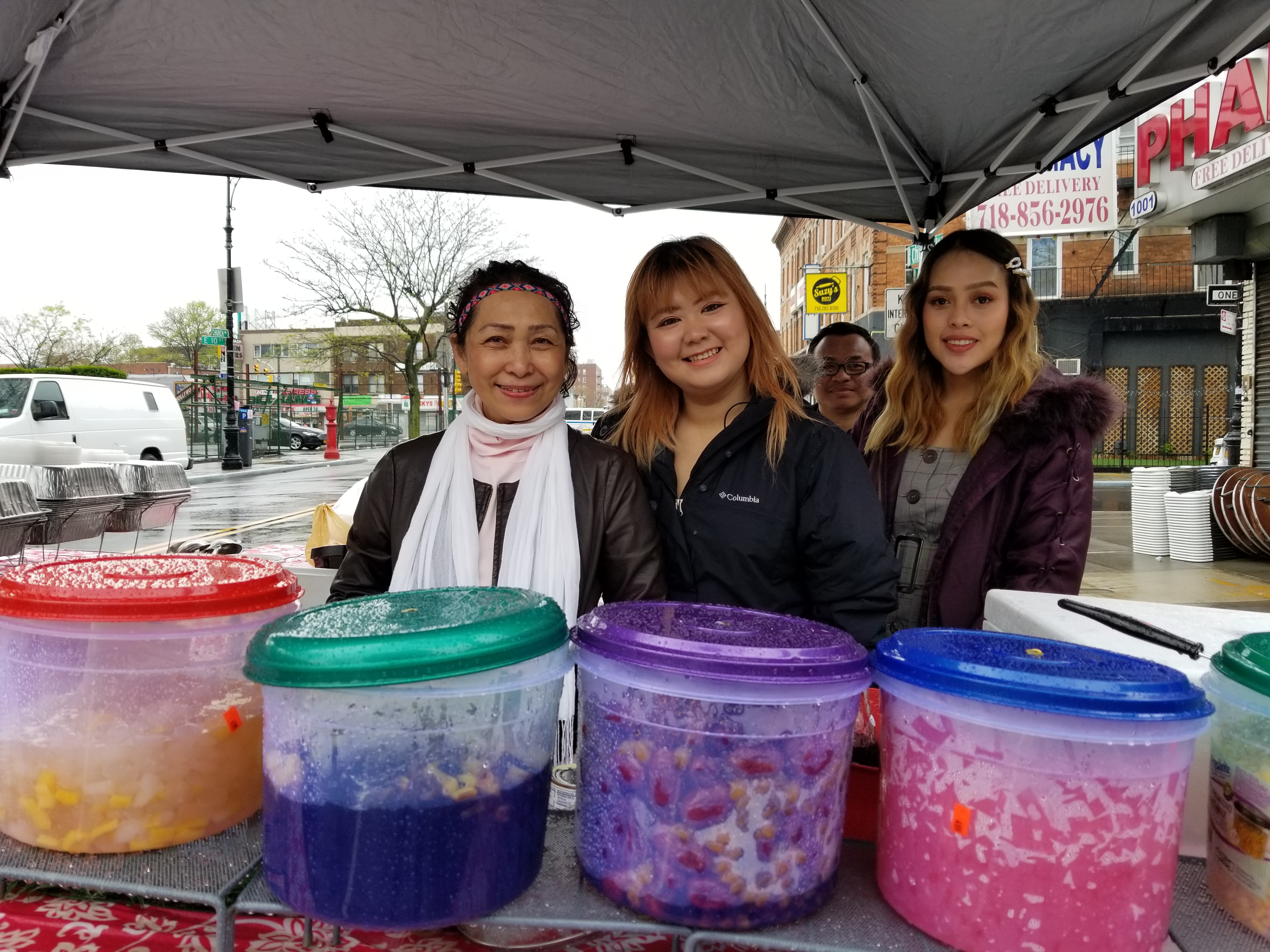
What challenges are you currently facing in your district?
Our challenges include keeping the BID as clean as possible, a reason why we increased our assessment a few years ago to add quarterly overnight graffiti removal. We are pleased with our decade of advocacy for the installation of new sidewalks throughout the Church Avenue BID and our follow-up with the city to ensure that businesses were aware of which blocks were slated for construction throughout the yearlong project. Next on our wish list: push for a long-overdue renovation and upgrade of the high-traffic Church Avenue B/Q subway station.
Are there any legislative and/or policy issues that you’re currently focused on?
We are focused on policies that impact the business owner-employee relationship, those that guide the complexities of commercial leases and working with the Department of Transportation to explore improved ways to implement transportation policies in neighborhoods. We are also looking for ways to improve the census count in Flatbush – a historically undercounted community – so our community receives the dollars it needs.
Downtown Brooklyn Partnership
Manages:
MetroTech Business Improvement District (founded January 1992)
Court-Livingston-Schermerhorn Business Improvement District (founded June 2007)
and Fulton Mall Improvement Association (founded June 1976)
Leader: Regina Myer, president
Budget: $11.8 million
Key projects: Creating a unified vision for long-term improvements to Downtown Brooklyn’s public spaces; Downtown Revitalization Initiative funding; Brooklyn’s first shared street was launched this year; the design and construction of Willoughby Square Park; and the Brooklyn-Queens Connector.
A Q&A with the Downtown Brooklyn Partnership
What challenges are you currently facing in your district?
Creating a cohesive, planned public realm that keeps pace with the investment that has been made in the area. We’re very, very focused on making Downtown Brooklyn beautiful as well as pedestrian- and bike-friendly. While reconstruction of the Brooklyn-Queens Expressway has the potential to bring vast improvements, the repercussions of traffic diversions during construction could cause a decade of headaches.
What accomplishments are you most proud of?
The construction and opening of Betty Carter Park this summer. Securing $10 million in state funding for key Downtown Brooklyn projects – based on our Brooklyn Strand plan. Our ongoing work with organizations of the Brooklyn Cultural District, and our commitment to securing public art for the area. Moving the needle on the overdue creation of Willoughby Square Park and playing a key role in the creation of a truly mixed-use neighborhood.
How has the focus of your organization evolved over the years?
As the neighborhood has gone through unprecedented growth and transformed from a location for government back offices into a vibrant mixed-use neighborhood, the Downtown Brooklyn Partnership has adapted to the new landscape to go above and beyond customary BID functions. This can be seen in such initiatives as our free outdoor programming, our work with local colleges to connect students with the burgeoning tech sector, our extensive research and marketing efforts aimed at promoting the neighborhood and attracting commercial tenants and residents.
Are there any legislative and/or policy issues that you’re currently focused on?
The renewal of real estate tax incentives, such as the Relocation and Employment Assistance Program, in the state legislative session. Any increase in vending permits must be accompanied by serious regulation of the industry. Effective enforcement of placard parking rules. Ensuring the city’s commitment to the Brooklyn-Queens Connector.
Dumbo Improvement District
Leader: Alexandria Sica, executive director
Budget: $1.3 million
Key projects: Reconstruction of Dumbo’s Belgian block streets, the Dumbo Archway, and growing Dumbo and Brooklyn’s tech scene.
Founded: December 2005
A Q&A with the Dumbo Improvement District
What accomplishments are you most proud of?
Dumbo 2.0 has arrived: We now have a fully built-out waterfront, bustling tourist scene, an office space market that keeps bringing in top companies like Rent the Runway, and a growing residential population. Right now, we’re tackling infrastructure. Our streets and water and sewer are being modernized through a $100 million city reconstruction project.
How has the focus of your organization evolved over the years?
The Dumbo Improvement District started off as an advocacy organization, with a bit of sanitation work on the side. Today, we’re still very much focused on advocating for the final pieces of Dumbo’s revitalization like the subway and park upgrades, but we’re also really focused on keeping the neighborhood true to its creative roots and community-focused.
Are there any legislative and/or policy issues that you’re currently focused on?
We’re working on the renewal of the Relocation and Employment Assistance Program. Also, the vending situation in Dumbo can be intense. We’d like the NYPD to have more powerful tools to punish the trucks who park in crosswalks, and we want to work with the city and state to direct vendors to areas of the neighborhood that make the most sense.
East Brooklyn Business Improvement District
Leaders: Sherry Roberts, executive director; Bill Wilkins, BID manager
Budget: $142,500
Key projects: Brush removal; contracting opportunities; customer service and quality control; employee assistance and training; financial assistance; graffiti removal; marketing services; ombudsman services; pest control; real estate assistance; sanitation services; tax incentives
Founded: July 1985
A Q&A with the East Brooklyn BID
.JPG)
What challenges are you currently facing in your district? What accomplishments are you most proud of?
One of the larger issues the East Brooklyn BID has been facing is illegal dumping. Accomplishments that the East Brooklyn BID is proud of is partnering with the event Industry & Art. The East Brooklyn BIDannually hosts a trip for National Manufacturing Day with students from the Trey Whitfield School. Last year, the students were joined by Councilman Rafael Espinal. They spent the day touring companies located in the East Brooklyn BID and were introduced to the world of manufacturing.
How has the focus of your organization evolved over the years?
From birth to present, we advocate for industrial and manufacturing businesses. We are the voice for light industrial manufacturing in New York City.
Are there any legislative and/or policy issues that you’re currently focused on?
A legislative issue that we focused on was the special permit that requires developers to convert industrial zone property into storage facilities or transient hotels.
Flatbush Avenue Business Improvement District
Leaders: Lauren Elvers Collins, executive director; Ezra Ashkenazi, board chairman
Budget: $386,000
Key projects: Sidewalk sales; supplemental sanitation seven days per week; holiday lights, including new gateway welcome lighting in the main colors of the Haitian flag; annual street fair; upcoming safer streets security initiative; and the annual Thanksgiving luncheon.
Founded: July 1988
A Q&A with the Flatbush Avenue BID
What challenges are you currently facing in your district? What accomplishments are you most proud of?
We continually address sanitation issues, and recently have been working with the local precinct to help gather the information they need to remove graffiti quickly when it occurs. We’re looking for ways to deal with illegal dumping, which is an ongoing problem. Commercial vacancies are an issue throughout the city, and we are looking into more effective ways to share vacancy listings with realtors and prospective businesses. We’re proud of our recent visual enhancements, specifically our Distinction art competition, which gathered submissions from local artists interpreting their view of what makes Flatbush unique.
How has the focus of your organization evolved over the years?
As the way people shop changes and regulations on small business continue, we have been modifying our focus to increased digital marketing to reach more shoppers as well as helping more of our businesses get an online presence. We are working to increase the number of sit-down restaurants on this bustling section of Flatbush Avenue, especially in the blocks surrounding the majestic Kings Theatre, and also to accommodate current retail shoppers and the influx of residents moving into new residential buildings.
Flatbush Nostrand Junction Business Improvement District
Leaders: Kenneth Mbonu, executive director; Kevin Johnson, board chairman
Budget: $300,000
Key projects: A summer market initiative with artists selling products made strictly from recycled and salvaged materials; a creative coalition that facilitates connections between local businesses and artists; a fellowship where artists work with businesses to upgrade their
storefronts and window displays; the installation of a public pedestrian plaza, Hillel Plaza
Founded: May 2006
A Q&A with the Flatbush Nostrand Junction BID
.png)
What challenges are you currently facing in your district?
Managing the growing homeless population crisis.
What accomplishments are you most proud of?
The application of art and design to enhance economic value with small businesses. Keeping our commercial vacancy rate at a low 3%. The Acquisition International’s business excellence global award winner as “Best Socio-Economic Community Development Program 2018.”
How has the focus of your organization evolved over the years?
Our focus has evolved primarily to working with small businesses on various creative sustainability strategies.
Are there any legislative and/or policy issues that you’re currently focused on?
We support the Small Business Jobs Survival Act proposal.
Fulton Area Business Alliance
Leader: Phillip Kellogg, executive director
Budget: $638,082
Key projects: Creating four new public spaces, including two recently completed pedestrian plazas – Fowler Square and Putnam Triangle – plus various pedestrian safety improvements.
Founded: December 2008
A Q&A with the Fulton Area Business Alliance
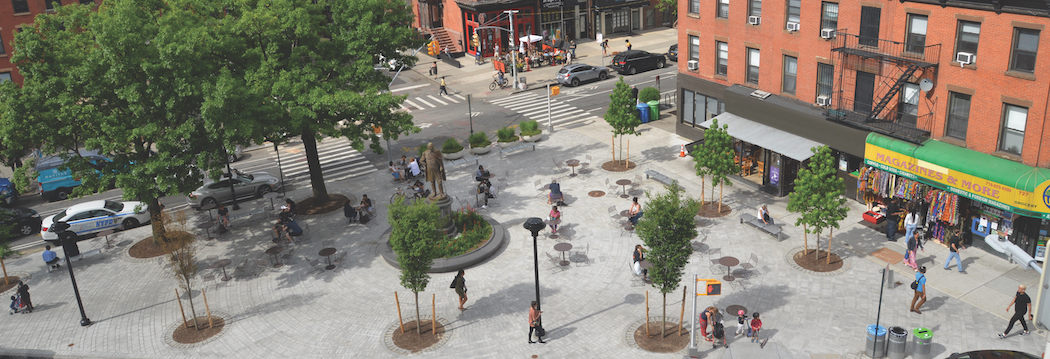
What accomplishments are you most proud of?
The Fulton Area Business Alliance has secured $9.2 million in funding in the form of grants, sponsorships and in-kind support over the past 10 years for initiatives that will benefit the entire community for decades to come, including new pedestrian plazas at Fowler Square and Putnam Triangle.
What challenges are you currently facing in your district?
Rent pressures are significant, especially for our longtime businesses.
How has the focus of your organization evolved over the years?
The transformation of Fulton Street’s public spaces and the community processes they went through, plus working with city agencies to get them designed and constructed, has been a significant investment of resources. The area’s increasing population and foot traffic means maintenance and public-space management will be a priority.
Are there any legislative and/or policy issues that you’re currently focused on?
The Fulton Area Business Alliance works in partnership with its colleagues in BIDs across the city on issues of mutual concern, including unfunded mandates that increase the cost of being in business and competing demands for the use of streets and sidewalks.
Graham Avenue Business Improvement District
Leaders: Betty M. Cooney, executive director; Katherine Gold, president
Assessment: $250,000
Key projects: Seven day a week sanitation program and graffiti removal; annual fiesta; independent farmers market; Holiday Santa bus and holiday lights and banners; ADA educational support; community mural projects
Founded: July 1987
A Q&A with the Graham Avenue BID
What challenges are you currently facing in your district?
In an area that is experiencing rapid gentrification, the BID tries to maintain the Hispanic heritage of the community while welcoming new residents. Growth is important to any retail district, but we work to support our smaller businesses by incorporating the old and established mom and pop businesses with the larger national chains. We strive to find the right mix of retail businesses that can be supported by our changing demographics and the proliferation of internet shoppers. Rising commercial property taxes have impacted on our smaller businesses as leases continue to rise. We work to support the interests of our property owners and seek to find solutions to help retain our smaller businesses.
Are there any legislative and/or policy issues that you’re currently focused on?
Legislatively, we are working to make our district buildings ADA compliant. This not only serves the physically handicapped, but also our large senior population. We want all shoppers to comfortably access our services. We have always been and continue to be a welcoming retail district for all. The Graham Avenue BID, also known as the Avenue of Puerto Rico, has been and continues to be a friendly and accommodating place for families to shop and call home.
Grand Street Business Improvement District
Leader: Erin Piscopink, executive director
Budget: $315,000
Key projects: Over the last year, we’ve added several public art murals throughout the district. We’re especially proud to have commissioned a work called “Olor a Azucenas el Perfum del Barrio” on one of our larger building facades. We connected with a Puerto Rican artist with ties to our neighborhood to create a work that honors both the small-business owners of Grand Street as well as the Puerto Rican heritage of this community.
Founded: July 1985
A Q&A with the Grand Street BID
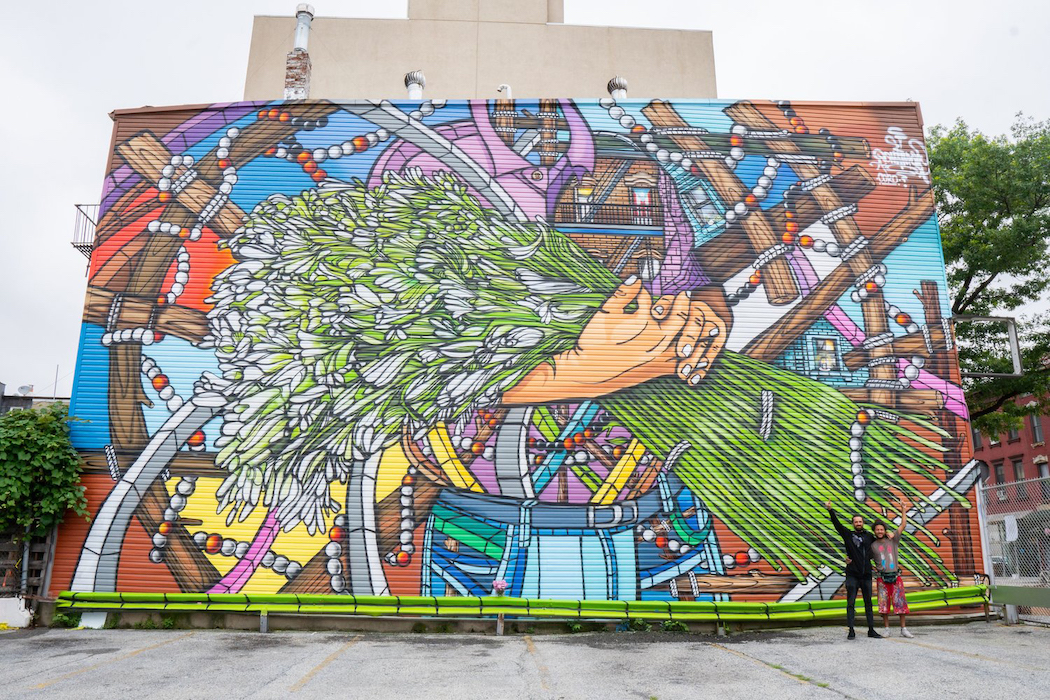
What challenges are you currently facing in your district?
Our district is located in an area of Williamsburg that has historically been a cultural melting pot. We have long-standing Puerto Rican and Italian communities, one of the city’s first public housing projects, and now have an influx of new residents who are reshaping the neighborhood’s demands from the commercial corridor. This means that our mostly service-oriented businesses have had to adapt to attract the neighborhood’s diverse and growing residential population. The BID is working to help break down some of the perceived barriers we hear about in the community by sharing the stories and histories of our legacy businesses with newcomers, and creating opportunities for longtime residents to engage with newer businesses through our events and promotions.
What accomplishments are you most proud of?
Over the past year, we’ve increased our focus on telling Grand Street’s stories. We believe that our community has remained special and unique and wanted to tap into that character by using our communications to create more personal connections between the businesses and residents. We have already seen some of these digital connections we’re creating lead to in-person connections between business owners and new customers, and we are seeing deeper sense of community and belonging being fostered.
Kings Highway Business Improvement District
Leaders: Phil Nuzzo, executive director; Malcolm Newman, president
Budget: $350,000
Key projects: Sanitation, social media promotion, graffiti removal and holiday lighting
Founded: January 1990
A Q&A with the Kings Highway BID
What challenges are you currently facing in your district?
Parking, diminished foot traffic due to online shopping, side street big-box stores.
What accomplishments are you most proud of?
Extended parking hours; stopped limited bus service lanes; beautiful, clean, almost suburban atmosphere; innovative social media promotions.
How has the focus of your organization evolved over the years?
From infrastructure and day-to-day focus (extending parking hours, peddler control, graffiti control, stopping bus lanes and loss of parking) to more promotion of the district (social media, in-house commercial videos, Google advertising).
Montague Street Business Improvement District
Leaders: Kate Chura, executive director; Greg Markman, board president
Budget: $230,000
Key projects: Renovation of the Brooklyn-Queens Expressway to include a foot bridge to Brooklyn Bridge Park.
Founded: January 1998
A Q&A with the Montague Street BID
What challenges are you currently facing in your district?
The upcoming renovation of the (Brooklyn-Queens Expressway) will be incredibly disruptive to the district. The initial design by (the Department of Transportation) would have destroyed key landmarks in the area that brings thousands of visitors who dine, shop and experience all that the merchants on Montague Street and the surrounding area have to offer.
How has the focus of your organization evolved over the years?
When I came on board about four years ago, we took a deep dive into how we were promoting the businesses in the district. A quick and comprehensive plan to better market the merchants was put in place and continues to be reviewed and updated frequently.
Are there any legislative and/or policy issues that you’re currently focused on?
(We’re) working feverishly to help enact changes that will allow merchants and property owners a cost-effective solution to become more compliant (with the Americans with Disabilities Act) in both their physical space as well as virtual presence. Commercial vacancy is a major issue throughout New York City. We are hoping a Brooklynwide vacancy study will launch in 2020.
Myrtle Avenue Brooklyn Partnership
Leader: Chad Purkey, executive director
Budget: $924,000
Key projects: Managing the Myrtle Avenue Plaza, monthly food pantry, youth employment and entrepreneur mentorship program, and initiatives to support residents in local shelters.
Founded: April 2005
A Q&A with the Myrtle Avenue Brooklyn Partnership
.JPG)
What challenges are you currently facing in your district? What accomplishments are you most proud of?
We are proud of our organization’s comprehensive approach to community development, effectively serving property owners, business owners and residents from across our neighborhood’s broad economic spectrum. Specific accomplishments include: our custom tree guard program, which has installed 100 pieces of functional public art; our storefront improvement program, which has assisted $3.2 million in property investment; our cultural programming that inclusively celebrates our neighborhood’s history, including our annual Black Artstory Month series.
How has the focus of your organization evolved over the years?
At the onset, our work focused on reducing the (commercial) vacancy rate – above 25% in 1999 – which required creating an inviting district, (including) removing graffiti, investing in storefront improvements, installing street trees, and diversifying the district’s retail mix on Myrtle (Avenue). Over the years, after largely successfully tackling those challenges, we’ve been able to expand our services beyond these core commercial district services and focus on long-term capital projects, hosting free community events and serving residents with a variety of programs.
North Flatbush Business Improvement District
Leaders: James Ellis, executive director; Regina Cahill, president
Budget: $246,495
Key projects: Completing multiyear streetscape initiative that includes green street plaza expansions, pedestrian safety measures, water main upgrades and installation of large-scale tree planters; supporting the installation of public art; and a sanitation education program for residents and businesses.
Founded: January 1986
A Q&A with the North Flatbush BID
What challenges are you currently facing in your district?
The implementation of new (New York City Department of Sanitation) policies for commercial and residential waste, and educating community members as to appropriate practices. Retail vacancies and the shift in consumer buying habits. How to support merchant members in the uncertain times on retail; forces of regulation, space needs, rents, and (the) cost of doing business (and) finding the right business plan.
What accomplishments are you most proud of?
Last year, we were able to successfully eliminate the Clear Curbs pilot program that was burdensome to the district due to eliminating street parking for six hours of the day Monday through Friday.
How has the focus of your organization evolved over the years?
In the beginning, we were focused on “survival” and safety issues. We now are able to promote the district as a neighborhood asset – a livable strip with destination and lifestyle-focused businesses. Historically, the district businesses operated from 7 a.m. to 5 p.m. with goods for the trades and home improvements. We now have fitness, food and services that cater to the ever-transitioning neighborhood.
Park Slope Fifth Avenue Business Improvement District
Leaders: Mark Caserta, executive director; Joanna Tallantire, deputy director; Erika Clark, board president
Budget: $575,000
Key projects: Cleaning and greening, special events to promote Fifth Avenue, holiday lights, and direct merchant support and advocacy on a daily basis.
Founded: June 2008
A Q&A with the Park Slope Fifth Avenue BID
What challenges are you currently facing in your district?
We work hard every day to walk our district and talk to our merchants about their challenges and needs. We are very concerned about the combined effects of higher rents, rising property taxes – which merchants pay a large portion of – difficult city regulations, online competition and increased labor costs.
How has the focus of your organization evolved over the years?
While it’s important to focus on the needs of our district, we have worked to make sure that our efforts support the needs of the larger Park Slope community. We want the BID to be a community asset and a good partner.
Are there any legislative and/or policy issues that you’re currently focused on?
We are concerned about any city policy that will impose another cost on our small businesses without offering financial assistance. Our merchants are stretched to the limit and any additional unfunded mandate could easily put them out of business.
Pitkin Avenue Business Improvement District
Leaders: Daniel Murphy, executive director; Mark Tanis, board chairman
Budget: $425,000
Key projects: Facade improvement grants, neighborhood events like the Easter and Halloween parades, holiday tree lighting, conversions of the avenue to activated pedestrian plazas, district marketing and local business development.
Founded: October 1993
A Q&A with the Pitkin Avenue BID
What challenges are you currently facing in your district? What accomplishments are you most proud of?
We face the same challenges from online retailers as many other neighborhood main streets. We also lack the direct access to rapid transit that is a boon for destination districts in the city. In spite of these challenges and the lingering effects of decades of disinvestment, we have managed to physically transform the district into a safe, clean, commercial district with new investment in a historic retail district.
How has the focus of your organization evolved over the years?
The BID was an organization that focused strictly on security and sanitation. These are still fundamental necessities for any public use space. The focus over the past 10 years has been to gain more buy-ins from the local community and build a resilient district utilizing in-place existing resources like historic architecture and human capital.
Are there any legislative and/or policy issues that you’re currently focused on?
We have received grant funding to put money in the pockets of locally engaged business (and) building owners who invest in improvements to properties. We believe government can do even more to entice locally established businesses to keep up their properties.
Sunset Park Business Improvement District
Leaders: David Estrada, executive director; Delvis Valdes, board chairman
Assessment: $300,000
Key projects: Supplemental sanitation, including sweep (and) bag operations for corner waste baskets, and custom graffiti removal; holiday season Fifth Avenue lighting and annual tree lighting ceremony with children’s gift bags and a free old fashioned trolley; National Night Out in partnership with the NYPD 72nd Precinct and an annual fall 15-block street festival.
Founded: July 1995
A Q&A with the Sunset Park Business Improvement District
What challenges are you currently facing in your district? What accomplishments are you most proud of?
The Fifth Avenue shopping corridor between 39th and 64th streets is contending with aging infrastructure. Our lighting fixtures, streets and curbs, signage and sidewalks require frequent maintenance. We also face sanitation challenges like illegal advertisements, construction dumping and household waste in street corner baskets. In response to a ticket blitz by the Department of Buildings on unlicensed store signs, we helped advance legislation that placed a moratorium on new fines, offered relief to stores with citations and created a mayoral task force to review and revise store sign regulations.
Are there any legislative and/or policy issues that you’re currently focused on?
Immense rezoning applications on private properties like Industry City, together with New York Economic Development Corp. investments in city-owned properties on the Sunset Park waterfront, have the potential to adversely impact microbusinesses. We’re also concerned about initiatives that impact the streetscape like WalkNYC, wayfinding kiosks, LinkNYC Wi-Fi stations and the anticipated arrival of protected bike lanes on Fourth Avenue, Citi Bike docks and dedicated car-sharing parking locations. We favor a complete overhaul of street vending regulations. We’re pushing for congestion pricing and a thoughtful reprovisioning of MTA bus lines in South Brooklyn.
Correction: This story's intro incorrectly stated that New York City's BIDs began in Manhattan; in fact, the city's first BID was Fulton Mall Improvement District in Brooklyn.


